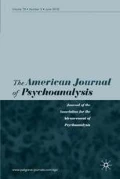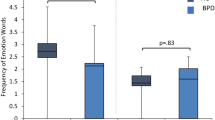Abstract
The purpose of this study was to identify subgroups of borderline personality disorder (BPD) by examining internalized object relations. It was predicted: (a) that the internalized object relations of borderline patients as a group can be differentiated from psychiatric patients (comparison group N = 15), and (b) that BPD subgroups significantly differ in their object-relational profiles. Fifty-seven adult borderline subjects (28 male and 29 female) were separated into three groups based on Horney's description of interpersonal styles (moving away, against, and toward). Object relations were assessed using the Bell Object Relations Inventory and from early memories. Four written early memories were scored using the Social Cognition and Object Relations Scale (SCORS). The results suggest that the malevolent inner object world of borderline patients is fundamentally different from nonborderline psychiatric patients; and that the defined BPD subgroups of moving toward, against, and away differed significantly on specific structural and thematic object-relational dimensions. Aspects from Fairbairn's object relations theory and contributions from the self/representational, ego deficit, and Kernberg's models of borderline psychopathology are used to help interpret the findings. Identifying subtypes of BPD may allow for more precise discriminations in separating BPD from other disorders and may provide meaningful therapeutic and prognostic information for the different subgroups of borderline patients.
Similar content being viewed by others
REFERENCES
Ackerman, S. J., Hilsenroth, M. J., Clemence, A. J., Weatherhill, R., & Fowler, J. C. (2001). Convergent validity of Rorschach and TAT scales of object relations. Journal of Personality Assessment, 77, 295–306.
Acklin, M. W., Bibb, J. L., Bozen, P., & Jain, V. (1991). Early memories as expressions of relationship paradigms: A preliminary investigation. Journal of Personality Assessment, 57, 177–192.
Adler, G. (1985). Borderline psychopathology and its treatment. Northvale, NJ: Jason Aronson.
Arnow, D., & Harrison, R. H. (1991). Affect in early memories of borderline patients. Journal of Personality Assessment, 56, 75–83.
Bell, M. D., Billington, R., & Becker, B. (1986). A scale for the assessment of object relations: Reliability, validity and factorial invariance. Journal of Clinical Psychology, 42, 733–741.
Bell, M. D., Billington, R., Cicchetti, D., & Gibbons, J. (1988). Do object relations deficits distinguish BPD from other diagnostic groups? Journal of Clinical Psychology, 44, 511–516.
Blanck, G., & Blanck, B. (1979). Ego psychology II. New York: Columbia University Press.
Blatt, S. J., Brennis, C. B., Schimek, J. G., & Glick, M. (1976). Normal development and psychopathological impairment of the concept of the object in the Rorschach. Journal of Abnormal Psychology, 5, 364–373.
Blatt, S., & Lerner, H. (1983). The psychological assessment of object representation. Journal of Personality Assessment, 47, 7–27.
Bower, G. H. (1990). Awareness, the unconscious, and repression: An experimental psychologist's perspective. In J. Singer (Ed.), Repression and dissociation: Implications for personality, theory, psychopathology, and health (pp. 209–231). Chicago: University of Chicago Press.
Bruhn, A. R. (1990). Earliest childhood memories: Vol. 1. Theory and application to clinical practice. New York: Praeger.
Buie, D. H., & Adler, G. (1973). The uses of confrontation in psychotherapy of borderline cases. In G. Adler & P. G. Myers (Eds.), Confrontation in psychotherapy (pp. 123–146). New York: Science House.
Cashdan, S. (1988). Object relations therapy: Using the relationship. New York: W. W. Norton.
Celani, D. P. (1993). The treatment of the borderline patient: Applying Fairbairn's object relations theory in the clinical setting. Madison, CT: International Universities Press.
Chessick, R. D. (1974). Defective ego feeling and the quest for being in the borderline patient. International Journal of Psychoanalytic Psychotherapy, 3, 73–89.
Cornell, D. G., Sild, K. R., Ludolph, P. S., & Lohr, N. E. (1983). Test-retest reliability of the diagnostic interview for borderlines. Archives of General Psychiatry, 40, 1307–1310.
Engelman, E. (1985). Level of object representation in depression: A longitudinal study. Unpublished doctoral dissertation, Adelphi University.
Fairbairn, W. R. D. (1944). Endopsychic structure considered in terms of object relationships. International Journal of Psycho-analysis, 25, pts 1 & 2.
Fairbairn, W. R. D. (1952). An object relations theory of the personality. New York: Basic Books.
Fairbairn, W. R. D. (1955). Observations in defense of the object relations theory of the personality. British Journal of Medical Psychology, 28, 144–156.
Farris, A. A. (1988). Differential diagnosis of borderline and narcissistic personality disorders. In H. D. Lerner & P. A. Lerner (Eds.), Primitive mental states and the Rorschach (pp. 299–337). Madison, CT: International Universities Press.
Faris, M. A. (1989). Differential diagnosis of borderline and narcissistic personality disorders. In H. D. Lerner & P. M. Lerner (Eds.), Primitive mental states and the Rorschach (pp. 299–337). Madison, CT: International Universities Press.
Frosch, J. (1967). Psychoanalytic considerations of the psychotic character. Journal of the American Psychoanalytic Association, 15, 606–625.
Gartner, J., Hart, S. W., & Gartner, A. (1989). Psychological tests signs of borderline personality disorder: A review of the empirical literature. Journal of Personality Assessment, 53, 413–441.
Giovacchini, P. (1979). The many sides of helplessness: The borderline patient. In J. LeBoit & A. Capponi (Eds.), Advances in psychotherapy of the borderline patient (pp. 227–267). New York: Jason Aronson.
Greene, L. R. (1996). Primitive defenses, object relations, and symptom clusters in borderline psychopathology. Journal of Personality Assessment, 67, 204–304.
Grinker, R., Sr., Werble, B., & Drye, R. (1968). The borderline syndrome. New York: Basic Books.
Gunderson, J. G., & Zanarini, M. C. (1983). Diagnostic interview for borderlines-revised. Unpublished manuscript.
Guntrip, H. (1961). Personality structure and human interaction: The developing synthesis of psycho-dynamic theory. New York: International Universities Press.
Horney, K. (1937). The neurotic personality of our time. New York: Norton.
Horney, K. (1945). Our inner conflicts. New York: Norton.
Horney, K. (1950). Neurosis and human growth. New York: Norton.
Kernberg, O. (1975). Borderline conditions and pathological narcissism. New York: Jason Aronson.
Kernberg, O. (1976). Object relations theory and clinical psychoanalysis. New York: International Universities Press.
Kernberg, O. (1984). Severe personality disorders: Psychotherapeutic strategies. New Haven: Yale University Press.
Klein, M. (1975). Some theoretical conclusions regarding the emotional life of the infant. In M. Klein (Ed.), Envy and gratitude and other works, 1946-1963. New York: Delacorte Press. (Original work published 1952)
Knox, J. (1997). Internal objects-a theoretical analysis of Jungian and Kleinian models. Journal of Analytical Psychology, 42, 653–666.
Koenigsberg, H. W., Kernberg, O. F., & Schomerr, J. (1983). Diagnosing borderline conditions in an outpatient setting. Archives of General Psychiatry, 40, 49–53.
Kohut, H. (1971). The analysis of the self: A systematic approach to the psychoanalytic treatment of narcissistic personality disorders. New York: International Universities Press.
Krohn, A., & Mayman, M. (1974). Objective representations in dreams and other projective tests. Bulletin of the Menninger Clinic, 38, 445–466.
Lerner, H. D., & Lerner, P. M. (1983). Multiple dimensions of object relations in neurotic, borderline, and schizophrenic patients. In C. D. Spielberger & J. N. Butcher (Eds.), Advances in personality assessment (pp. 53–57). Hillsdale, NJ: Erlbaum.
Lerner, H. D., & St. Peter, S. (1984). Patterns of object relations in neurotic, borderline and schizophrenic patients. Psychigla, 47, 77–92.
Masterson, J. (1976). Psychotherapy of the borderline adult: A developmental approach. New York: Brunner/Mazel.
Masterson, J. F. (1990). Psychotherapy of borderline and narcissistic disorders: Establishing a therapeutic alliance (A developmental, self, and object relations approach). Journal of Personality Disorders, 4, 182–191.
Masterson, J. F., & Rinsley, D. B. (1975). The borderline syndrome: The role of the mother in the genesis and psychic structure of the borderline personality. International Journal of Psychoanalysis, 56, 163–177.
Mayman, M. (1968). Early memories and character structure. Journal of Projective Techniques and Personalily Assessment, 32, 303–316.
McGlashan, T. H., & Heinssen, R. K. (1989). Narcissitic, antisocial and noncomorbid subgroups of borderline disorder. Psychiatric Clinics of North America, 12, 653–670.
Nigg, J., Lohr, W., Westen, D., Gold, L., & Silk, K. (1992). Malevolent object representations in borderline personality disorder and major depression. Journal of Abnormal Psychology, 101, 61–67.
Nigg, J. T., Silk, K. R., Westen, D., Lohr, W. E., Gold, L. J., Goodrich S., & Ogata, S. (1991). Object representations in the early memories of sexually abused borderline patients. American Journal of Psychiatry, 148, 864–869.
Nilsson, A. (1995). Differentiation between patients with schizophrenia and borderline disorders in the Percept-genetic Object-Relation Test, PORT. British Journal of Medical Psychology, 68, 287–309.
Reich, D. B., & Zanarini, M. C. (2001). Developmental aspects of borderline personality disorder. Harvard Review of Psychiatry, 9, 294–301.
Seinfeld, J. (1990). The bad object. Northvale, NJ: Jason Aronson.
Spear, W. (1980). The psychological assessment of structural and thematic object representations in borderline and schizophrenic patients. In J. Kwawer, G. Lerner, P. Lerner, & A. Sugarman (Eds.), Borderline phenomena and the Rorschach test (pp. 321–340). New York: International Universities Press.
Spear, W., & Lapidus, L. (1981). Qualitative differences in manifest object representations: Implications for a multidimensional model of psychological functioning. Journal of Abnormal Psychology, 49, 157–167.
Spear, W. E., & Sugarman, A. (1984). Dimensions of internalized object relations in borderline and schizophrenic patients. Psychoanalytic Psychology, 1, 113–129.
Stone, M. H. (1980). The borderline syndrome. New York: McGraw-Hill.
Stricker, G., & Healy, B. D. (1990). Projective assessment of object relations: A review of the empirical literature. Psychological Assessment, 2, 219–230.
Stuart, J., Westen, P., Lohr, N., Silk, K., Benjamin, J., Becker, S., & Varus, N. (1990). Object relations in borderlines, major depression, and normals: Analysis of Rorschach human figure responses. Journal of Personality Assessment, 55, 296–318.
Urist, J. (1977). The Rorschach test and the assessment of object relations. Journal of Personalily Assessment, 41, 3–9.
Westen, D. (1990). Towards a revised theory of borderline object relations: Contributions of empirical research. International Journal of Psycho-Analysis, 71, 661–693.
Westen, D., Barends, A., Leigh, J., Mendel, M., & Silbert, D. (1990). Social cognition and object relations scale (SCORS): Manual for coding interview data. Unpublished manuscript.
Westen, D., Ludolph, P., Lerner, H., Puffins, S., & Wiss, C. F. (1990). Object relations in borderline adolescents. Journal of the American Academy of Child and Adolescent Psychiatry, 29, 338–348.
Westen, D., Ludolph, P., Silk, K., Kellam, A., Gold, L., & Lohr, N. (1990). Object relations in borderline adolescents and adults: Developmental differences. Adolescent Psychiatry, 17, 360–384.
Zanarini, M. C., Gunderson, J. G., & Frankenburg, F. R. (1986). Diagnostic interview for borderlines-revised. Unpublished manuscript.
Zanarini, M. C., Gunderson, J. G., Frankenburg, F. R., & Chauncey, D. L. (1989). The revised diagnostic interview for borderlines: Discriminating BPD from other Axis II disorders. Journal of Personality Disorders, 3, 1018.
Zuckerman, M. (2000). Personality & risk to King: Common biosocial factors. Journal of Personality, 68, 999–1029.
Author information
Authors and Affiliations
Rights and permissions
About this article
Cite this article
Tramantano, G., Javier, R.A. & Colon, M. Discriminating Among Subgroups of Borderline Personality Disorder: An Assessment of Object Representations. Am J Psychoanal 63, 149–175 (2003). https://doi.org/10.1023/A:1024079115405
Issue Date:
DOI: https://doi.org/10.1023/A:1024079115405




